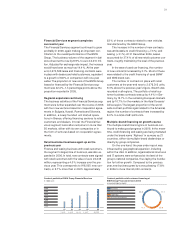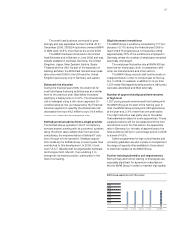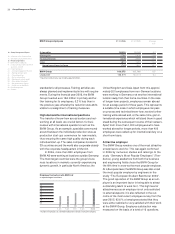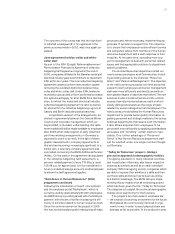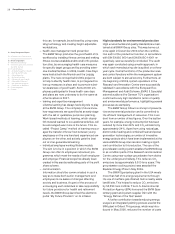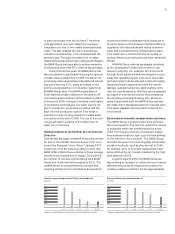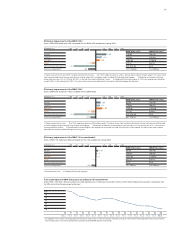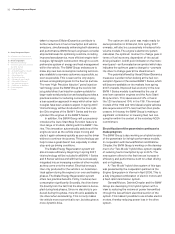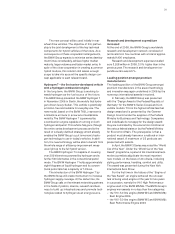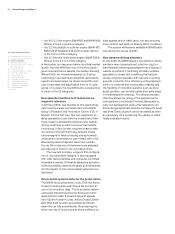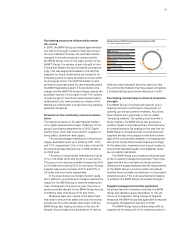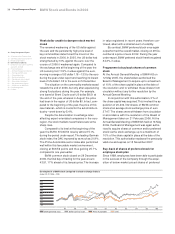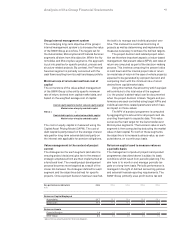BMW 2006 Annual Report Download - page 34
Download and view the complete annual report
Please find page 34 of the 2006 BMW annual report below. You can navigate through the pages in the report by either clicking on the pages listed below, or by using the keyword search tool below to find specific information within the annual report.33
The new concept will be used initially in rear-
wheel drive vehicles. The objective of this partner-
ship is the joint development of the key technical
components for hybrid vehicles of the future. As a
consequence of these cooperation arrangements,
the BMW Group expects to minimise series develop-
ment
times considerably, achieve higher market
maturity, larger volumes and faster market entry. In
spite of the close cooperation in creating a common
hybrid module, this solution still leaves enough
scope to take into account the specific design con-
cept applicable to each relevant brand.
Hydrogen 7 – the first series-developed vehicle
with a hydrogen combustion engine
In the long term, the BMW Group is working to-
wards hydrogen as the fuel source of the future.
The BMW Group presented the BMW Hydrogen 7
in November 2006 in Berlin, the world’s first hydro-
gen-driven luxury Sedan. This vehicle is practically
emission-free and suitable for everyday use.The
new model, based on the BMW 760Li,represents
a milestone en route to a new era of sustainable
mobility.The BMW Hydrogen 7 is powered by
a combustion engine capable of running on both
hydrogen and petrol.This vehicle has gone through
the entire series development process and
is the
result of a clearly-defined strategy, which
already
enables the BMW Group to put tomorrow’s hydro-
gen technology to use in today’s vehicles. In addi-
tion, the new technology will be able to benefit from
the whole range of efficiency improvement meas-
ures right up to the full hybrid version.
The BMW Hydrogen 7 is capable of covering
over 200 kilometres powered by hydrogen and a
further 500 kilometres in the conventional petrol
mode. The BMW Hydrogen 7 holds approximately
eight
kilograms of liquid hydrogen and its conven-
tional petrol tank has a capacity of 74 litres.
The introduction of the BMW Hydrogen 7 by
the BMW Group will create momentum to increase
hydrogen supply coverage. At the same time, the
BMW Group calls on the relevant networking partners
in the fields of politics, science, research and
busi-
ness to build up infrastructures and promote tech-
nologies
related to hydrogen as an energy source.
Research and development expenditure
increased
At the end of 2006, the BMW Group’s worldwide
research and development network consisted of
ten locations in five countries with a total of approxi-
mately 9,400 employees.
Research and development expenses totalled
euro 3,208 million in 2006, 3.0% higher than in the
previous year. The research and development ex-
penditure ratio was 6.5%.
Leading position amongst premium
manufacturers
The leading position of the BMW Group amongst
premium manufacturers in the area of technology
and innovation was again underlined in 2006 by the
numerous international awards it received.
In February, the BMW Group was presented
with the “Design Award of the Federal Republic of
Germany” for the BMW 6 Series Coupé and Con-
vertible models. This is the highest official German
design award and is presented by the German
Design Council under the auspices of the Federal
Ministry for Business and Technology. Companies
and individuals do not apply for the design award;
they are nominated by the economics ministries of
the various federal states or by the Federal Ministry
for Economic Affairs. The prerequisite is that a
product must already have won a national or inter-
national award. A maximum of 25 products are
presented
with awards.
In April, the BMW 3 Series was voted the “World
Car of the Year”. Under the “World Car of the Year
Award” programme, a panel of 46 international auto-
motive journalists adjudicate the most important
new models on the basis of 20 criteria, including
styling, performance, handling, comfort and utility.
The award was presented during the New York
International Auto Show.
For the first time in the history of the “Engine of
the Year Award”, an engine achieved the unusual
feat of being voted engine of the year for two years
in succession, namely the V-10 High Performance
engine used in the BMW M5/M6. The BMW Group’s
engines won awards in no less than five categories:
– the V10-5.0 litre engine (BMW M5 and BMW M6):
Best Engine 2006
– the V10-5.0 litre engine (BMW M5 and BMW M6):
Best Performance Engine 2006


